From DESY inForm: Light at the end of the magnet?
ALPS searching for very light particles
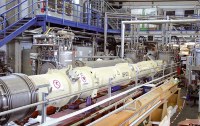
Inside this magnet the light may shine through the wall: the ALPS setup in the HERA magnet test hall. |
Admittedly, this sounds quite absurd at first sight – absurd, but also quite
fascinating. Imagine a world existing parallel to our world that we practically
do not perceive at all. Some scientific theories suggest that such a world exists,
but nobody has ever seen it. With unprecedented
accuracy, the ALPS (Any Light Particle Search) experiment
is now searching for particles from such
a world. In case it does exist, this would
immediately support new theory models
like string theory and also explain unresolved
phenomena like dark matter and dark energy. The problem is that the
suspected particles of this hidden world
are much lighter than everything we
know and they hardly interact with our
matter. They are called WISPs (weakly
interacting sub-eV particles).
Read more... (pdf)
|
 |
|
|
 |
Upcoming meetings, conferences, workshops
Lepton Photon 09
Hamburg, Germany
17-22 August 2009
14th International Conference on RF Superconductivity (SRF2009)
Berlin, Germany
20-25 September 2009
2009 Linear Collider Workshop of the Americas (ALCPG09)
The University of New Mexico, Albuquerque, New Mexico, USA
29 September - 3 October 2009
Upcoming schools
International School of Physics "Enrico Fermi" (SIF)
Radiation and particle detectors
Varenna, Villa Monastero, Italy
20-25 July
Linear Collider Physics School 2009
Ambleside, England
17-23 August 2009
Fourth International Accelerator School for Linear Colliders
Beijing, China
7-18 September 2009
|
|
|
GDE Meetings calendar
View complete ILC calendar
|
|
|
 |
Observe, explore and re-create the universe
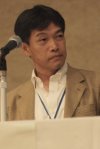
Tohru Takahashi answering the questions from symposium attendees. |
"Uchu (宇宙)" is the Japanese word that can be translated as either "universe" or "space." The Advanced Accelerator Association Promoting Science and Technology (AAA) in Japan has been on tour with their symposium series on "uchu" – observing by telescope, exploring by spacecraft and re-creating by accelerator – and the second event was just held in Hiroshima on 4 July.
Read more...
-- Rika Takahashi |
 |
|
|
 |
From DESY
21 July 2009
Schavan, Gundelach and Biel lay cornerstone at DESY
Federal Government, Hamburg and Schleswig-Holstein sign European XFEL participation agreement.
Read more... |
|
From Warrington Worldwide
20 July 2009
2,200 children "inspired by science"
More than 2,200 children from across the North West have been inspired to a greater interest in science as a result of working with the STFC Daresbury Laboratory, near Warrington in the past academic year.
Read more... |
|
From CERN
17 July 2009
CERN and EU Commission agree on closer scientific partnership
Geneva, 17 July 2009. Today in Brussels, CERN and the European Commission are to sign a Memorandum of Understanding (MoU), which aims to enhance the long-standing partnership between the two organizations.
Read more... |
|
From physicsworld
16 July 2009
Could Fermi detect dark matter within a year?
The Fermi Gamma-ray Space Telescope could detect the telltale signs of dark-matter annihilation in as little as a year, if calculations by UK and US astrophysicists prove correct.
Read more... |
|
From Economist
16 July 2009
The search for dark matter
Ethereal yet weighty: Two new ways to detect the elusive stuff of the universe
Read more... |
|
|
 |
 |
|
|
 |
Accelerator Design and Integration: Considerations for distributing high-level RF power for a single tunnel configuration
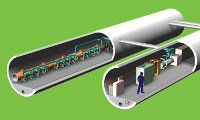
The ILC Reference Design uses a double-tunnel configuration with the klystron high-level RF system in an accessible service tunnel |
The main thrust of our ILC accelerator design work during the Technical Design Phase (TDP-1 and TDP-2) is to refine the design presented in the Reference Design Report (RDR) towards a more coherent concept, and one that is better optimised for performance to cost to risk. Our approach is to study a set of carefully chosen potential changes to the RDR baseline aimed at producing a new baseline next year as the final milestone in TPD-1. The new baseline will then become the basis of the technical design (TPD-2) that will be completed and documented by the end of 2012. One of the most complex and difficult changes under consideration is changing from the RDRís double-tunnel to a single-tunnel configuration. A key problem to solve for a single-tunnel configuration is how to deliver the high-level radiofrequency power (HLRF) to the cryomodules. There are two very different solutions being proposed, and the choice between them may be site dependent.
Read more...
-- Barry Barish
Director's Corner Archive |
 |
|
|
 |
Sun, sand and — particle tracks
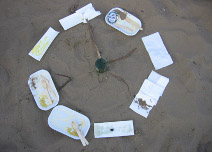 What happens when a bunch of physicists gather on a beach? They don't build sandcastles – they build event displays. Not just any kind of event display, of course – ones with a definite ILC team. That's what happened last week when members of the CALICE collaboration met in Hamburg – read the whole story (and an explanation of the tracks) in Quantum Diaries.
What happens when a bunch of physicists gather on a beach? They don't build sandcastles – they build event displays. Not just any kind of event display, of course – ones with a definite ILC team. That's what happened last week when members of the CALICE collaboration met in Hamburg – read the whole story (and an explanation of the tracks) in Quantum Diaries.
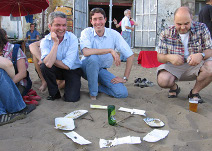
|
|
arXiv preprints
0907.3577
Particle Flow Calorimetry and the PandoraPFA Algorithm
0907.3455
On the physical Relevance of the Study of γ* γ → π0 π0 at small t and large Q2
0907.2782
Experimental Review of Photon Structure Function Data
0907.2662
WL WL Scattering in Higgsless Models: Identifying Better Effective Theories
0907.2589
Constraining SUSY models with Fittino using measurements before, with and beyond the LHC
|
|

